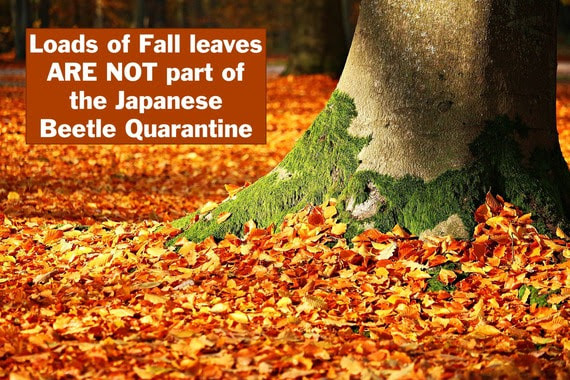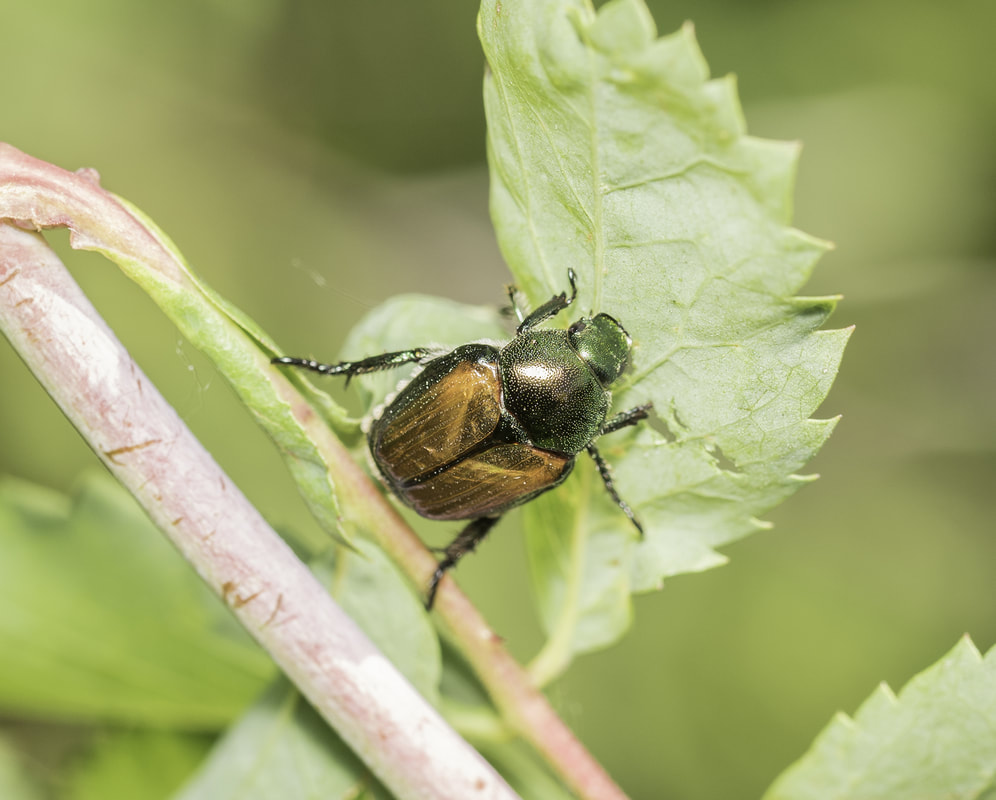|
Community Open House
Two drop-in style, open house's will be held this winter. The first event will take place at Meadow Park Middle School, from 5pm to 7pm Tuesday, February 12th. The second event will be held at the Cedar Mill Public Library, from 1pm to 3pm Saturday, February 22nd. Experts will be ready to answer your questions about the Japanese beetle project. Loads of fall leaves DO NOT need to be taken to the Japanese beetle yard debris drop off site in Hillsboro. Loads of fallen leaves are not a risk to spread Japanese beetle and are not part of the quarantined material. Please see the list below for material that falls within the quarantine. The yard debris quarantine is intended to prevent the spread of Japanese beetle in Oregon and to ensure the success of the current eradication program. The quarantine went into effect in Summer of 2017 and is still active through 2018. The boundary of the quarantine was expanded because of increased Japanese beetle detections in the county in 2017. The Oregon Department of Agriculture is asking all residents, landscapers, and waste managers that work in the yard debris quarantine area to adhere to the information below in order to comply with the quarantine to prevent the spread of both Japanese beetle adults and larvae:
Quarantined yard debris and material:
Not necessary or acceptable materials:
Note:
[TAGS: Washington County, Gardeners, Quarantine, Residents, Yard debris, Landscapers, Northwest Landscaping Services, Updates, Beetles in Oregon]
How can you identify a Japanese beetle? Japanese beetles have three main identifying characteristics:
The Japanese beetle is the only beetle in this area that has all three of these characteristics. There are a few other beetles in the area, both native and non-native, that are also metallic or otherwise look similar. Check out our Japanese beetle look alike guide to see who’s who. Examples of common beetles and pests that ARE NOT Japanese beetle: What to do if you come across some beetles? If you are within the treatment area and see adult Japanese beetles, then the ODA advises that you dispose of them in a container of soapy water. Using store bought insecticides will not significantly decrease Japanese beetle populations. If beetles are observed outside the treatment area, please put the specimen in a container or bag and email or call ODA at the contact information provided below. How long will this last?! Japanese beetles are already an issue being addressed in Washington County, and the issue can’t be solved overnight. It may take up to 5 years to eradicate the population entirely. How to help be part of the solution! Cooperation from those in the treatment area is critical to protect Oregon’s gardens and agricultural economy! Here’s what you can do to help:
[TAGS: Japanese beetle threat, Japanese beetle basics, Beetles in Oregon, Invasive species] Beetles can be moved in yard debris through the removal and movement of items such as sod and grass clippings. The risk of moving beetles is highest over the summer when adult beetles are emerging from the soil and moving around to feed and find mates. It is very important that beetles are contained within Washington County while treatment takes effect. Containment efforts are ramping up, with a quarantine on all yard debris still in effect and expanding in 2018. Residences will receive electronic notices from Oregon Department of Agriculture, along with other communications planned throughout the summer.
For more information about the quarantine check back on our Prevention page for the most recent information. [TAGS: Beetles in Oregon, Japanese beetle basics, Japanese beetle threat, Invasive species, Gardeners, Quarantine, Residents, Landscapers, Washington County, Yard debris] PLEASE NOTE: THIS POST IS AN ARCHIVE FROM THE 2017-2018 PROJECT YEAR. Second Treatment Wrapping Up in 2018 Thank you to residents and land managers in Washington County (Cedar Mill, Bethany and Oak Hills) and Oakland area that have been helping the Oregon Department of Agriculture beat the Japanese beetle! The Oregon Department of Agriculture (ODA) is currently wrapping up a second treatment in year two of the Japanese beetle eradication project. Support from resident in the area has been very positive. Before treatment, the ODA received over 5,000 responses from residents allowing ODA and their staff to treat the properties, including 30 Homeowners Associations supporting treatment in common areas. Tualatin Hills Parks and Recreation Department and the Beaverton School District are also supporting the project and allowing treatment to parks and school fields. Applicator crews have said that residents in the area are expressing their support for the project, with many "Thank you’s" and "Get those beetles!". Thank you to all of the residents who are working with us to protect Oregon’s plants and agriculture from this invasive species! Summary of the 2018 Treatment The ODA continued their relationship with General Tree Service to apply the same treatment as last year, a granular pesticide called Acelepryn G® which is a targeted larvicide that kills certain pests in their larval state in the soil. The granules are broadcasted on lawns and other landscaped areas, then it breaks down into the soil when it is watered in through rain or sprinklers. This pesticide is a “reduced risk” pesticide and is not considered a health threat for humans, pets, and other insects that don’t go through a larvae stage in treatment areas. According to the label, “Acelepryn G is recommended for Integrated Pest Management programs on turf and landscape ornamentals because it does not directly impact natural arthropod predator and parasitoid populations including ladybird beetles (aka ‘ladybugs’).” Since the treatment targets certain pest larvae in the soil, the treatment with Acelepryn G® has no adverse effects on pollinators when applied according to the label instructions. For more treatment & health information, please visit our Treatment page. A snapshot of the treatment area in Washington County
While there have been some delays due to weather, treatment has been able to be completed as scheduled due in large part to the hard work by application crews. A big shout out to the crews members and crew leads who are working long days, rain or shine, to make sure treatment is done correctly and on time. PLEASE NOTE: THIS POST IS AN ARCHIVE FROM 2017. Below is a sample of the plant damage that has been seen in the Cedar Mill area in the summer of 2017 as a result of the infestation of Japanese beetles. Damage on Rosa sp. from the Japanese Beetle. Photograph by Oregon Department of Agriculture. Japanese beetle caught feeding on a flower. Photograph by Oregon Department of Agriculture. Live beetle bites into unidentified plant leaf. Photograph by Oregon Department of Agriculture.
PLEASE NOTE: THIS POST IS AN ARCHIVE FROM 2017. Japanese beetles in floral pheromone traps in late July, 2017 in the Cedar Mill neighborhood. Photograph by Chris Hedstrom, ODA. View all current catches on the interactive map, here: As far as Japanese beetle habits go, the beetles are at the tail end of peak flight—which means there are many beetles flying—and it is important to use best management practices when disposing of the green waste and yard debris generated from this area.
Currently, the Oregon Department of Agriculture has detected over 12,000 adult beetles from our detection grids. Roughly 2% of these beetles have been found outside of the treatment area. The core of the infestation is located at the center of the treatment area, west of Saltzman Rd and Hartford St, in the Cedar Mill area. Some areas have a sporadic distribution of traps with beetles, possibly the result of beetles being transported on vehicles. However, one trapping area captured beetles consistently throughout a new area, which could indicate low-level infestation and may warrant expansion of the treatment and quarantine boundary in 2018. We will begin to analyze the information from this year’s surveillance activity to help us develop the 2018 response plan for year two of the eradication project, which begins spring of 2018. The Oregon Department of Agriculture will be seeking greater community support and likely additional funding to have a chance at eradicating this unprecedented amount of Japanese beetles in the Pacific Northwest. |
Header photograph by Whitney Cranshaw, bugwood.org
Categories
All
Archives
January 2024
|
|
This website is intended to provide readers with information that has been peer reviewed and produced from transparent and accountable sources. The Oregon Department of Agriculture is the lead agency for this project and maintains this website.
|
© COPYRIGHT 2018. ALL RIGHTS RESERVED.













 RSS Feed
RSS Feed
